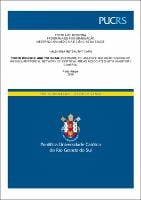| Share record |


|
Please use this identifier to cite or link to this item:
https://tede2.pucrs.br/tede2/handle/tede/8908Full metadata record
| DC Field | Value | Language |
|---|---|---|
| dc.creator | Cará, Valentina Metsavaht | - |
| dc.creator.Lattes | http://lattes.cnpq.br/6621453329214280 | por |
| dc.contributor.advisor1 | Buchweitz, Augusto | - |
| dc.contributor.advisor1Lattes | http://lattes.cnpq.br/7897187838595254 | por |
| dc.date.accessioned | 2019-10-02T13:01:30Z | - |
| dc.date.issued | 2018-06-28 | - |
| dc.identifier.uri | http://tede2.pucrs.br/tede2/handle/tede/8908 | - |
| dc.description.resumo | This study investigates the effects of preadolescent exposure to violence on brain function using functional magnetic resonance imaging (fMRI) and a task that tests executive functions. Executive functions are impaired in different disorders, and also as a result of adverse life conditions such as stress and abuse. Based on the literature, we hypothesized that exposure to violence would impact executive functions and their neurobiological correlates. The task performed during fMRI was a sustainned attetion task that tests for inhibitory control. Exposure to violence and behavior were investigated using self-reports (Juvenile Victimization Questionnaire and the Childhood Behavior Checklist). In total, 42 preadolescents (ages 10-14), recruited from public schools in one of the most violent cities in the world participated in the study. Results showed a significant negative correlation between the scores for exposure to violence and brain funtion in a fronto-parietal-insular network: preadolescents with higher levels of exposure to violence showed deactivation of bilateral insula and superior frontal cortex. These brain areas are associated with attention and inhibitory control. The findings provide evidence that preadolescent victimization and exposure to violence alters the neural patterns underlying executive functioning, and suggest that executive function tranining may be a candidate for targeted interventions in preadolescents exposed to violence. | por |
| dc.description.abstract | O objetivo deste estudo foi investigar os efeitos causados pela exposição crônica à violência em pré-adolescentes, utilizando-se de Ressonância Magnética Funcional (fMRI) e uma tarefa que testa funções executivas. Estudos sugerem que funções executivas podem se afetadas por diferentes enfermidades, como resultado de condições de vida desfavoráveis e exposição ao estresse e abuso. Com base na literatura, o presente estudo parte da hipótese de que exposição crônica à violência está associada com efeitos nas funções executivas e seus correlatos neurobiológicos. Realizou-se uma tarefa de atenção contínua que testa controle inibitório. Exposição à violência e comportamento foram analisados por meio de questionários autoaplicáveis validados para a língua portuguesa: o Juvenile Victimization Questionnaire (JVQ) o Child Behavior Checklist (CBCL). No total, participaram do estudo 42 pré-adolescentes (idades entre 10 e 14 anos), alunos de escolas públicas em uma das cidades mais violentas do mundo. Os resultados mostram uma associação (correlação negativa) entre exposição à violência e menos ativação em uma rede frontoparietal do cérebro, incluindo insula, cíngulo anterior e lobo parietal. Estas regiões cerebrais são associadas com atenção e controle inibitório. O estudo sugere que o aprimoramento de funções executivas pode ser um alvo de intervenções voltadas a pré-adolescentes cronicamente expostos a violência. | por |
| dc.description.provenance | Submitted by PPG Medicina e Ciências da Saúde ([email protected]) on 2019-08-12T12:07:22Z No. of bitstreams: 1 VALENTINA_METSAVAHT_CARA_DISSERTAÇÃO_FINAL.pdf: 2260693 bytes, checksum: 8757f5cf12691bde3c90eb903dade85b (MD5) | eng |
| dc.description.provenance | Rejected by Sheila Dias ([email protected]), reason: Devolvido devido à falta de resumo em português que é item obrigatório e a data de defesa do TEDE está diferente da data de defesa da folha da banca no trabalho. on 2019-08-19T12:39:29Z (GMT) | eng |
| dc.description.provenance | Submitted by PPG Medicina e Ciências da Saúde ([email protected]) on 2019-09-25T11:00:09Z No. of bitstreams: 1 VALENTINA_METSAVAHT_CARA_DISSERTAÇÃO_FINAL.pdf: 2302371 bytes, checksum: 45078c070daebe50424e5cabb9a77bd2 (MD5) | eng |
| dc.description.provenance | Approved for entry into archive by Sheila Dias ([email protected]) on 2019-10-02T12:51:46Z (GMT) No. of bitstreams: 1 VALENTINA_METSAVAHT_CARA_DISSERTAÇÃO_FINAL.pdf: 2302371 bytes, checksum: 45078c070daebe50424e5cabb9a77bd2 (MD5) | eng |
| dc.description.provenance | Made available in DSpace on 2019-10-02T13:01:30Z (GMT). No. of bitstreams: 1 VALENTINA_METSAVAHT_CARA_DISSERTAÇÃO_FINAL.pdf: 2302371 bytes, checksum: 45078c070daebe50424e5cabb9a77bd2 (MD5) Previous issue date: 2018-06-28 | eng |
| dc.format | application/pdf | * |
| dc.thumbnail.url | http://tede2.pucrs.br:80/tede2/retrieve/176559/DIS_VALENTINA_METSAVAHT_CARA_CONFIDENCIAL.pdf.jpg | * |
| dc.thumbnail.url | https://tede2.pucrs.br/tede2/retrieve/191821/DIS_VALENTINA_METSAVAHT_CARA_COMPLETO.pdf.jpg | * |
| dc.language | por | por |
| dc.publisher | Pontifícia Universidade Católica do Rio Grande do Sul | por |
| dc.publisher.department | Escola de Medicina | por |
| dc.publisher.country | Brasil | por |
| dc.publisher.initials | PUCRS | por |
| dc.publisher.program | Programa de Pós-Graduação em Medicina e Ciências da Saúde | por |
| dc.rights | Acesso Aberto | por |
| dc.subject | Neuroimaging | eng |
| dc.subject | Functional Magnetic Resonance | eng |
| dc.subject | fMRI | eng |
| dc.subject | Violence | eng |
| dc.subject | Preadolescents | eng |
| dc.subject | Executive Functions | eng |
| dc.subject | Inhibitory Control | eng |
| dc.subject | Insula | eng |
| dc.subject | Change Task | eng |
| dc.subject | Juvenile Victimization Questionnaire (JVQ) | eng |
| dc.subject | Child Behavior Checklist (CBCL) | eng |
| dc.subject.cnpq | CIENCIAS DA SAUDE::MEDICINA | por |
| dc.title | Youth violence and the brain : exposure to violence and deactivation of an insular-frontal network of cortical areas associated with inhibitory control | por |
| dc.type | Dissertação | por |
| dc.restricao.situacao | Trabalho será publicado como artigo ou livro | por |
| dc.restricao.prazo | 60 meses | por |
| dc.restricao.dataliberacao | 02/10/2024 | por |
| Appears in Collections: | Programa de Pós-Graduação em Medicina e Ciências da Saúde | |
Files in This Item:
| File | Description | Size | Format | |
|---|---|---|---|---|
| DIS_VALENTINA_METSAVAHT_CARA_COMPLETO.pdf | VALENTINA_METSAVAHT_CARA_DIS | 2.25 MB | Adobe PDF |  Download/Open Preview |
Items in DSpace are protected by copyright, with all rights reserved, unless otherwise indicated.




